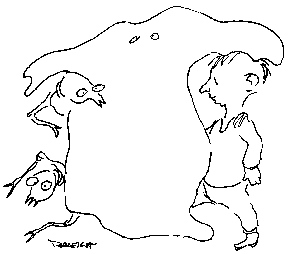 |
Something Else to Watch Out For
By
HENRY P. RALEIGH
ART TIMES Jan/Feb 2009
WAY
BACK IN 1913. A fellow named Edward Bullough noticed there was something
funny about fog. He was on a boat at sea when it entered a fog bank
and everyone on board, including himself, got pretty antsy because
you couldn’t see a damn thing. Even objects close by looked a bit
blurry and misshapen. His wife, hanging on the deck railing but a
few feet away, appeared in the swirling murk like one of the witches
of Endor just as he had begun to suspect she was, anyhow. Right off
the bat he labeled this effect ‘psychical distance’, a sense of being
separated from reality and not being keen about it, either. Unfortunately
Mr. Bullough also called this sensation a ‘disjointedness’ and much
later a group of youths misunderstood his theory and applied it to
mean things like, ‘Hey man, try dis joint, it’s far out’ — the
‘distance’, you see.
Now
Mr. Bullough’s ‘psychical distance’ was actually an idea he had
about the aesthetic response to art and early filmmakers apparently
became very fond of it, especially the fog part. And, as you know,
there hasn’t been a vampire, a werewolf, a Frankenstein, or Jack
the Ripper film since “Nosferatu” that doesn’t have a generous lathering
of fog all over the place. One of the obvious advantages of loads
of fog, besides its creepiness, is its ability to conceal shoddy
sets and over-the-hill actors. And it’s cheap, too.
Still,
fog remained no more than background to the blood-sucking people
and other monsters that wandered through its enveloping billows,
a mere second-banana, so to speak, even waiting at times for a full
moon before making a decent entrance. There was simply no recognition
for the major contribution fog made to any film it was in. Well,
it was that way until 1980 when John Carpenter, following the success
of “Halloween”, decided to do something about it. Clint Eastwood
had made a half-hearted effort when in 1971 he tossed in a bit of
California’s coastal fog at the beginning of “Play Misty for Me”.
However, this was entirely misleading and the ‘misty’ had no dramatic
connection to the fog who had thought the film’s title would at
least give it some cast credit. Well, Sir, Mr. Carpenter changed
all that with “The Fog”, a film that made fog the central motivation
factor, up-staging all the actors including Jamie Lee Curtis, pressing
up against windows, sneaking under doors, spewing out pirates a
mile a minute. Fog at least had come into its own, taking a place
alongside cornfields as fearsome things that we must watch out for.
As we have learned now from this and previous movies, fogs and cornfields
(see my earlier report on the horror of cornfields) conceal all
manner of terrible things.
“The
Fog” was not the end of fog’s hideous career. In 2007 came “The
Mist”, although I have some reservations about the title. A mist
to me is something that sprays out of an aerosol can and the mist,
so called, in the film seems to have the consistency of vanilla
pudding — it’s really a fog and a pretty thick one at that.
A rose by any other name, I suppose, yet I feel you should call
something for what it is, no matter that you’ve lifted the plot
from a Stephen King novel and some other director has a lock on
the title. At any rate, “The Mist” is a fair vehicle for fog, academy
award performance without a doubt despite a certain shakiness in
the story’s rationale. To say a fog loaded with gigantic flesh-eating
bugs had slipped out a window to another world opened by a military
experiment and let it go at that doesn’t really satisfy. There were
other confusions especially regarding the conclusion and I figure
the writers got into lot
of argument until finally one of them said, ‘To hell with it; at
the end of 196 minutes the cast must be exhausted so we’ll have
the lead human actor shoot all the remaining principals and be done
with it’ — and they did.
I
must offer a caution here, something to think about. You might recall
that any film which has a scene or two taking place in heaven shows
a great deal of fog — it’s just all over. True, it’s not the
sort of fog that seems to be reaching out to grab you; more a bouncy,
cottony type. “Here Comes Mr. Jordan” and its remake, “Heaven Can
Wait”, come to mind. Why, when Robert Montgomery and Warren Beatty
walk about heaven they kick up a little non-threatening puffs of
the stuff. What does this mean? Are somewhere in heaven’s fog enormous
killer insects and vengeful pirates just waiting for you? Isn’t
that supposed to be situated elsewhere? Surely there is a difference
between a sinister, vanilla pudding fog and the Marshmallow Fluff
fog that makes up a filmic heaven. It’s something to think about,
I can tell you.
